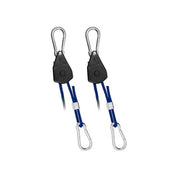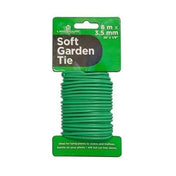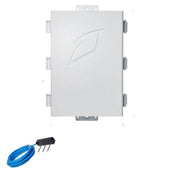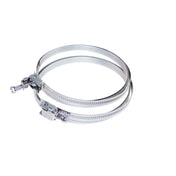AC fans (such as RVK) have been an industry workhorse for decades; helping growers exhaust and scrub hot, smelly air from their grow rooms time-after-time, rarely missing a beat. While they’re an ideal choice for those looking for a cheap and effective straightforward solution to a straightforward problem, they have their drawbacks and are generally surpassed by newer EC technology.
What’s the difference between AC and EC fans?
Essentially, it comes down to how the fan motor is powered and regulated. Traditionally, when powering a fan motor from a standard UK mains supply, the alternating current (AC) provided by this supply offers an alternating polarity (at a frequency of 50-60hz) that can be utilised by the electromagnets in the fan to generate rotational force. Because the technology used in AC motors is fairly straightforward, they've existed and been a staple for many years. The cost of manufacturing these fans is also relatively low, so it's easy to see why they've been - and continue to be - the first choice for new growers and those on a strict initial budget, especially when they're just used normally at full power.
EC motors on the other hand represent a real technological leap, converting the alternating current (AC) to direct current (DC) and then utilising sophisticated electronics to provide polarity to the electromagnets and modulate speed.
Why do I need an EC fan?
While operating AC fans normally at full power is certainly effective at removing air, should you need to reduce the fan speed below its default ‘full speed’ setting, you may encounter that infamous ‘hum’ or ‘buzz’ when paired with certain controllers. This noise is essentially created by the electrical inefficiency of this process, as wasted electricity is converted into sound (you’ll often still be using full power even though your fan isn’t running at full speed!). In order to eliminate this problem, you’ll need to spend more money on an additional controller that comes with the relevant coils and electronics needed to eliminate this noise. Even then, you’ll be limited by the pre-set fan speed ‘steps’ and will often be unable to utilise lower speed settings with bigger fans, as the motors simply aren’t designed to be run at those currents.
While these controllers are far from ideal, they’ve been the best solution to this problem for growers over the years. Thankfully, the introduction of EC technology has changed the rules of the game and now fully controllable, energy-efficient operation at any speed is possible straight out of the box. It no longer makes sense to purchase an AC fan with an expensive speed controller to correct for inefficiencies when it’s now possible to buy a quality EC fan and controller bundle for the same price or cheaper.
EC fans are designed to run smoothly and efficiently at any speed, only consuming the exact electricity needed for that specific speed setting – in fact, the vast majority of EC fans will come with a linear variable speed controller, while many (such as the Mountain Air Silent EC or U-Go EC fan range) will come with thermostatic controllers as standard or as an optional extra. Overall, the ability to seamlessly transition between fan speeds makes them much better at adapting to varying environments across all seasons, saving you energy and money in the process.
Just to give you a basic example: An RVK A1 6” (£87) provides 428m3/hr using 59 watts of electricity. A Rhino 6” EC fan (£150) provides 594m3/hr using only 40 watts. A similar airflow rate of 428m3/hr can be achieved by lowering the speed and reducing power consumption to 72%, using only 29w (half the power of an RVK for equivalent airflow). At current prices (34p per KWH) and a typical 5 year lifespan, this will provide a saving of around £447!
So which EC Fan Should I buy?
This will depend on exact needs, but when replacing an AC fan with an EC fan, a safe bet is to stick to the same diameter and look for a similar airflow rate (m3/hr), while ensuring that the airflow rate of the replacement fan doesn’t exceed the maximum rating of your carbon filter (unless you have full confidence in your ability to control fan speed below this limit). Those needing quiet operation should opt for a silenced version; if you’re making other efficiency upgrades to your grow area (such as replacing HID/HPS with LED), then it may be possible to go a size smaller, however the general principle of ‘bigger is better’ should apply to EC fans; by running a larger fan on a lower speed setting, you’ll reduce the noise and increase lifespan considerably. Do this with a silent EC fan and it’s possible to reduce the sound of your extraction fan to a whisper. Take a look at some top EC fan picks below:
Top Tip:
Combine a thermostatically controlled EC fan with a thermostat such as the G.A.S Day & Night Temperature Controller (for your heater) and you’ve got an unbeatable efficiency combination. Set your fan controller a couple of degrees above your heat controller and you’ll never unnecessarily over-heat your space. Swap your HPS for an LED Grow Light and take things to the next level!













